An Interview with Renos Panagidis, PCC Instructor
By Adrienne Harvey, SrPCC, RKC-II, CK-FMS
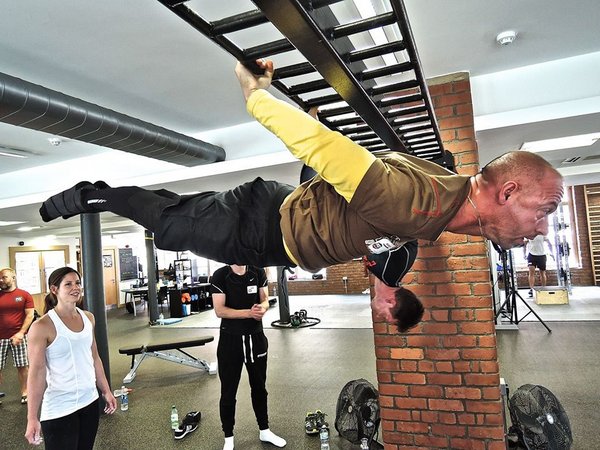
Dragon Door: How did you first become involved in fitness—your own training, and training others?
Renos Panagidis: When I was child, I watched Rocky Balboa movies everyday and wanted to be champion like him. So when I was 10 years old I started boxing. At the age of 13, I became a member of the Cyprus National Boxing Team. For ten years, I worked very hard and won many competitions in Cyprus and abroad with the help of my trainer. After that I tried MMA for a year just for new techniques and more experience, and I started track sports for more conditioning and better flexibility.
Then, I was looking for a challenge and had seen videos of
Al and
Danny Kavadlo for years. I started CrossFit because I couldn’t find any calisthenics gyms in my country.
One afternoon I read about the PCC and thought that this would be a great challenge for me. The next day I converted my garage into a calisthenics gym and began training myself with Al and Danny’s videos. Later I found a gym center and started training there (and still do). Now here I am, proud to be a
Dragon Door PCC Instructor!
Dragon Door: Did you come to the PCC mainly for your own training, or will you be training others?
Renos Panagidis: I came to the PCC for the experience—I wanted to train with Al and Danny—and also because I want to train other people in the future. So, I wanted to train with the best teachers and to see all the
calisthenics techniques live. Also, I would love to train other people, because I love sports and working with people. It is wonderful to see people happy with their results. This is the beauty of the job!
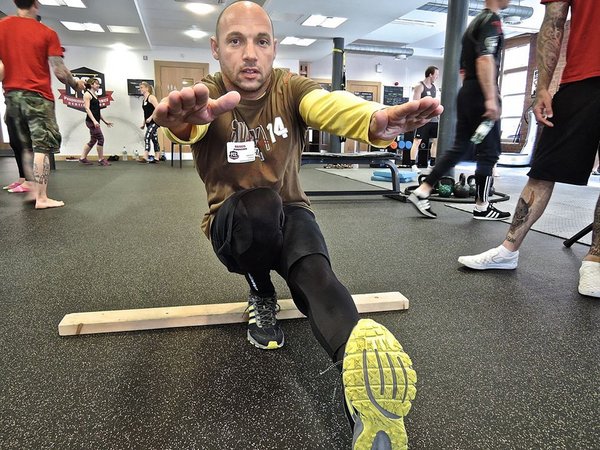
At the moment, I’m not training anyone in a gym, but in a year I will start training others in gym-based calisthenics. Right now I am in the Cyprus army and we do a lot of services, but what I like the most is training the new groups of soldiers. Usually, I train my soldiers all together as a team. My aim is to help them all follow and complete the program we have for the day. This is the beauty of team spirit, I try to help everyone finish the workout of the day. Every soldier must be ready for the battlefield—we are a country under Turkish possession.
I train the soldiers four times a week. For conditioning, we start running at seven o'clock in the morning for 30 minutes, during that time we stop every 10 minutes to do 30
push-ups. Then, we go for 40 pull-ups—and this is on day one. The next day we run for 30 minutes and stop every 10 minutes for 20 burpees, then we train the abs/core. The following day we run for 40 minutes and at the end we practice squats and lunges. On the last training day of the week we play football or basketball for an hour just for fun.
Calisthenics is one of the most excellent ways to train and we must start showing everyone inside and outside of the army that it is a real sport that everyone should follow.
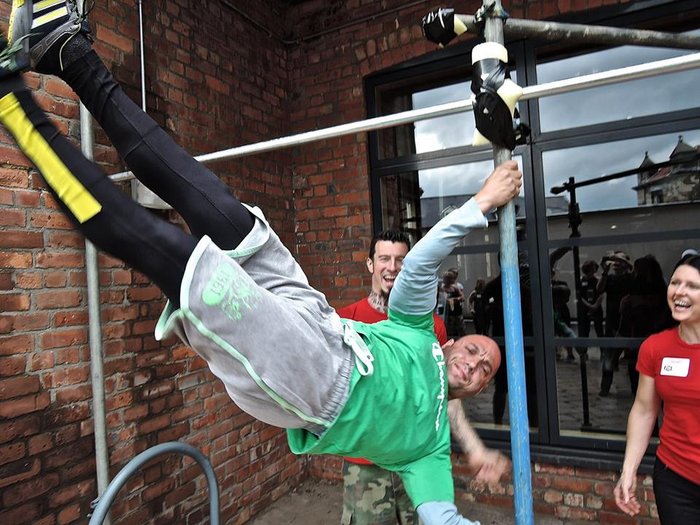
Dragon Door: What is your favorite calisthenics movement, and what do you like about it?
Renos Panagidis: I think all of the movements are great, but my favorites are the
human flag and the muscle-up. Every move has its own techniques, but I think the best way to learn the human flag is to lock your shoulders and your elbows like you are a horizontal pole. To improve, you must practice staying there for at least 20 seconds. If you are a beginner you must try it first with bent legs, and then you can start with one leg straight, then both.
For the
muscle-up you must keep both feet in front of you, then create space between you and the bar. Once you are over the bar, lean your weight forward to help press yourself up. I like these two movements because the human flag is one of the greatest bodyweight challenges, and the muscle-up is a skill that combines a pull-up followed by a dip—it’s two exercises in one.
Dragon Door: Other than the exercises you already mentioned using with the soldiers—push-ups, running, pull-ups, burpees, squats, lunges—what moves from the PCC do you think could further benefit their workouts?
Renos Panagidis: I think dips and
hanging leg raises will help them to be stronger than ever before. I plan to propose everyone in my unit starts to do these two exercises. Dips are a compound bodyweight exercise that will help them build their chests, shoulders, backs and arms. This exercise has everything, and is one of the best.
With a little imagination, hanging leg raises can be done anywhere—there are plenty of trees everywhere. This movement is really good for the hardcore guys. The hanging leg raises work all the muscles of the midsection, the lats, and also gives you a strong grip—something we all need.
Dragon Door: I remember you did your first one-arm chin-up at the recent UK PCC Workshop. How did you train towards it and what do you think made it happen for you at the workshop?
Renos Panagidis: Yes indeed, I achieved my first one-arm chin-up at the PCC. It was a great feeling for me. Pull-ups were one of my favorite exercises when I was a child, and l still love doing pull-ups. We can do them on anything and everything we can hang from. In the past, I attempted the one arm pull-up but failed. At the time, I told myself the exercise was for stronger athletes, but that wasn’t true, I failed because I didn’t have the technique or the power to do it.
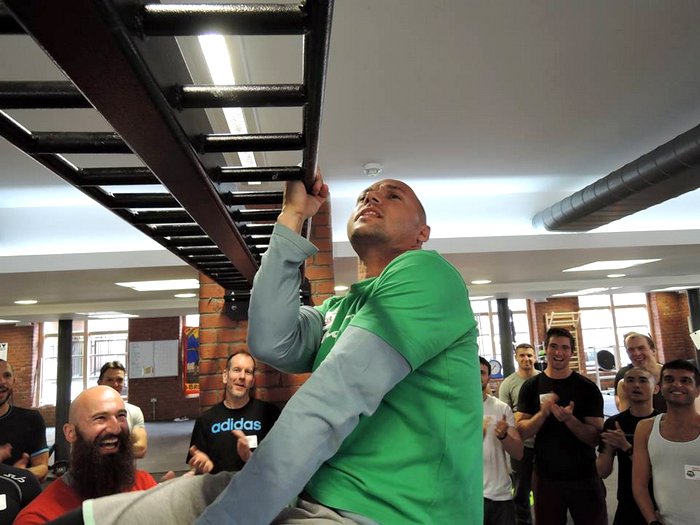
But one day I decided that I must start working on the one-arm pull-up again. I started with the uneven pull-up (one hand holding on to the bar and my other hand holding that wrist, then I would switch hand positions). But this exercise still uses both arms, and I could still only achieve about 30% of a one-arm pull-up. Then I came to the PCC and saw Al Kavadlo doing
one-arm pull-ups—it was amazing. He showed us the technique and how to do it. Al inspired me to try doing a full one-arm pull-up again, and I was able to do it because I saw his technique and finally believed I could do it. Basically, I think the best way to do it is to train, have the best teacher (for me that’s Al), and believe in yourself.
Dragon Door: What’s your next goal? Are you working towards anything specific right now?
Renos Panagidis: One of the things I need to improve is my
flexibility—it’s my weakness! Flexibility leads to greater ease of movement, less stiffness and reduced joint pain. My short term flexibility goals include going to a one hour yoga, Pilates or tai chi class twice a week. I am also want to start doing 30 minutes of stretching three times a week or at least five minutes stretching daily after exercise.
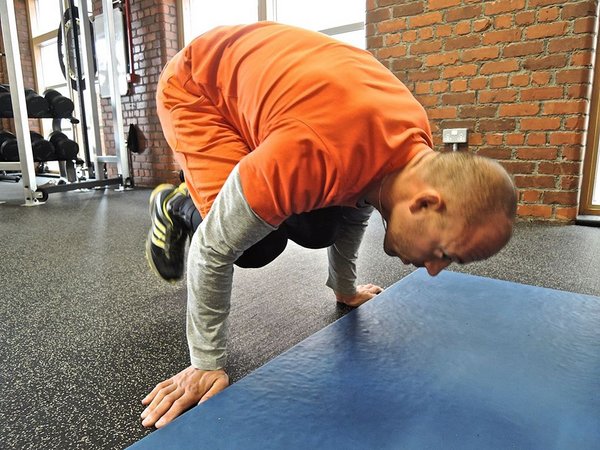
At the moment I am also working to improve my
bridge. I can’t do it correctly yet because my shoulders are not very flexible. So, for the past two months I have been working on mobility for 10 minutes after every training for five days a week, and I do yoga for one hour a week. I have already seen a lot of difference in my flexibility. Now I don’t have any pain and my bridge is already getting better thanks to stretching.
Dragon Door: Do you have a favorite bodyweight workout or combination of bodyweight exercises you enjoy?
Renos Panagidis: Basically, I love doing circuits for all the muscles of the body. I feel like I work harder and get stronger with this type of workout. I change my program every month which seems better for my muscles. My favorite bodyweight workout begins with three rounds of skipping rope for three minutes as a warm up. For the main core training, I do standing ab wheel roll-outs for three rounds of ten reps, then I do three rounds of thirty-second L-sit holds. Next, I do three rounds of hanging leg raises for fifteen reps and three rounds of hanging wipers for fifteen reps. For legs I do thirty jumping lunges and thirty wall squats with a medicine ball. Next, I do forty diamond push-ups and then three rounds of triceps extensions for ten reps. Then, because I like the
kettlebell swing, I’ll do three rounds of fifteen swings. For my back and my biceps, I do two rounds of regular pull-ups and two rounds of chin-ups—twenty reps of each exercise. It’s a difficult workout, but I have
seen full body results very quickly.
Dragon Door: What’s your advice for someone who is preparing for the PCC Workshop?
Renos Panagidis: Everyone should train and prepare for the
Century Test—it is not a game. While it may seem easy to some, I recommend that everyone prepare by practicing a harder version of the test. Go for more than 100 reps. If you work harder then you will be able to finish the test with ease. When training for the PCC, I ran for ten minutes before starting the test, which I did with extra reps: 50
squats, 40 push-ups, 20 hanging leg raises and finished with 15 pull-ups. I always made sure to use the right technique. Training with extra reps makes finishing the test at the PCC easier.
At the PCC they teach the best techniques because they are the best teachers. Remember to relax and have fun!
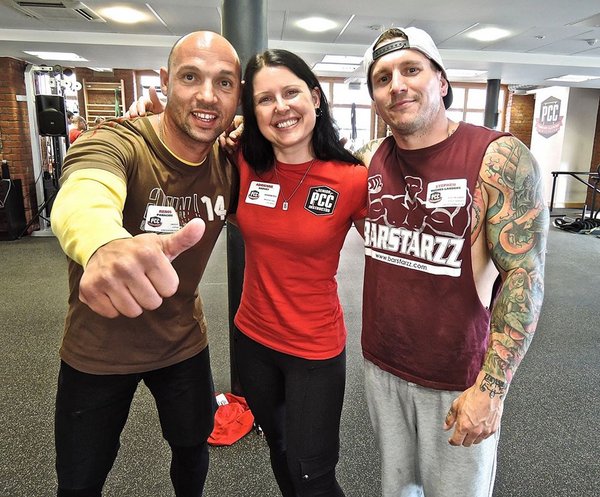
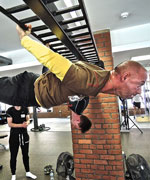 Renos Panagidis is a PCC Instructor, a trainer for Cyprus Army, and martial arts athlete.
Renos Panagidis is a PCC Instructor, a trainer for Cyprus Army, and martial arts athlete.
Back